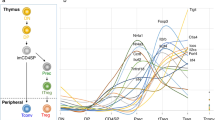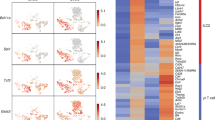Abstract
Immune homeostasis is dependent on tight control over the size of a population of regulatory T (Treg) cells capable of suppressing over-exuberant immune responses. The Treg cell subset is comprised of cells that commit to the Treg lineage by upregulating the transcription factor Foxp3 either in the thymus (tTreg) or in the periphery (iTreg)1,2. Considering a central role for Foxp3 in Treg cell differentiation and function3,4, we proposed that conserved non-coding DNA sequence (CNS) elements at the Foxp3 locus encode information defining the size, composition and stability of the Treg cell population. Here we describe the function of three Foxp3 CNS elements (CNS1–3) in Treg cell fate determination in mice. The pioneer element CNS3, which acts to potently increase the frequency of Treg cells generated in the thymus and the periphery, binds c-Rel in in vitro assays. In contrast, CNS1, which contains a TGF-β–NFAT response element, is superfluous for tTreg cell differentiation, but has a prominent role in iTreg cell generation in gut-associated lymphoid tissues. CNS2, although dispensable for Foxp3 induction, is required for Foxp3 expression in the progeny of dividing Treg cells. Foxp3 binds to CNS2 in a Cbf-β–Runx1 and CpG DNA demethylation-dependent manner, suggesting that Foxp3 recruitment to this ‘cellular memory module’ facilitates the heritable maintenance of the active state of the Foxp3 locus and, therefore, Treg lineage stability. Together, our studies demonstrate that the composition, size and maintenance of the Treg cell population are controlled by Foxp3 CNS elements engaged in response to distinct cell-extrinsic or -intrinsic cues.
This is a preview of subscription content, access via your institution
Access options
Subscribe to this journal
Receive 51 print issues and online access
$199.00 per year
only $3.90 per issue
Buy this article
- Purchase on Springer Link
- Instant access to full article PDF
Prices may be subject to local taxes which are calculated during checkout




Similar content being viewed by others
References
Sakaguchi, S., Yamaguchi, T., Nomura, T. & Ono, M. Regulatory T cells and immune tolerance. Cell 133, 775–787 (2008)
Zheng, Y. & Rudensky, A. Y. Foxp3 in control of the regulatory T cell lineage. Nature Immunol. 8, 457–462 (2007)
Gavin, M. A. et al. Foxp3-dependent programme of regulatory T-cell differentiation. Nature 445, 771–775 (2007)
Williams, L. M. & Rudensky, A. Y. Maintenance of the Foxp3-dependent developmental program in mature regulatory T cells requires continued expression of Foxp3. Nature Immunol. 8, 277–284 (2007)
Ruthenburg, A. J., Allis, C. D. & Wysocka, J. Methylation of lysine 4 on histone H3: intricacy of writing and reading a single epigenetic mark. Mol. Cell 25, 15–30 (2007)
Birney, E. et al. Identification and analysis of functional elements in 1% of the human genome by the ENCODE pilot project. Nature 447, 799–816 (2007)
Heintzman, N. D. et al. Distinct and predictive chromatin signatures of transcriptional promoters and enhancers in the human genome. Nature Genet. 39, 311–318 (2007)
Tone, Y. et al. Smad3 and NFAT cooperate to induce Foxp3 expression through its enhancer. Nature Immunol. 9, 194–202 (2007)
Kim, H. P. & Leonard, W. J. CREB/ATF-dependent T cell receptor-induced FoxP3 gene expression: a role for DNA methylation. J. Exp. Med. 204, 1543–1551 (2007)
Burchill, M. A., Yang, J., Vogtenhuber, C., Blazar, B. R. & Farrar, M. A. IL-2 receptor β-dependent STAT5 activation is required for the development of Foxp3+ regulatory T cells. J. Immunol. 178, 280–290 (2007)
Rao, S., Gerondakis, S., Woltring, D. & Shannon, M. F. c-Rel is required for chromatin remodeling across the IL-2 gene promoter. J. Immunol. 170, 3724–3731 (2003)
Liu, Y. et al. A critical function for TGF-β signaling in the development of natural CD4+CD25+Foxp3+ regulatory T cells. Nature Immunol. 9, 632–640 (2008)
Polansky, J. K. et al. DNA methylation controls Foxp3 gene expression. Eur. J. Immunol. 38, 1654–1663 (2008)
Maurange, C. & Paro, R. A cellular memory module conveys epigenetic inheritance of hedgehog expression during Drosophila wing imaginal disc development. Genes Dev. 16, 2672–2683 (2002)
Yao, Z. et al. Nonredundant roles for Stat5a/b in directly regulating Foxp3 . Blood 109, 4368–4375 (2007)
Ono, M. et al. Foxp3 controls regulatory T-cell function by interacting with AML1/Runx1. Nature 446, 685–689 (2007)
Rudra, D. et al. Runx-CBFβ complexes control expression of the transcription factor Foxp3 in regulatory T cells. Nature Immunol. 10, 1170–1177 (2009)
Kitoh, A. et al. Indispensable role of the Runx1-Cbfβ transcription complex for in vivo-suppressive function of FoxP3+ regulatory T cells. Immunity 31, 609–620 (2009)
Bruno, L. et al. Runx proteins regulate Foxp3 expression. J. Exp. Med. 206, 2329–2337 (2009)
Fontenot, J. D. et al. Regulatory T cell lineage specification by the forkhead transcription factor Foxp3. Immunity 22, 329–341 (2005)
Lee, E. C. et al. A highly efficient Escherichia coli-based chromosome engineering system adapted for recombinogenic targeting and subcloning of BAC DNA. Genomics 73, 56–65 (2001)
Dubchak, I. & Ryaboy, D. V. VISTA family of computational tools for comparative analysis of DNA sequences and whole genomes. Methods Mol. Biol. 338, 69–89 (2006)
Zheng, Y. et al. Genome-wide analysis of Foxp3 target genes in developing and mature regulatory T cells. Nature 445, 936–940 (2007)
Sather, B. D. et al. Altering the distribution of Foxp3+ regulatory T cells results in tissue-specific inflammatory disease. J. Exp. Med. 204, 1335–1347 (2007)
Acknowledgements
We thank T.-T. Chu and L. Karpik for expert technical assistance and mouse colony management, S. Roh for embryonic stem cell culture and screening, J. Rasmussen and A. Kas for bioinformatics support, A. Beg for providing c-Rel knockout mice, P. Treuting for histopathology analysis, J. Gerard for assistance in luciferase reporter assays, and C. Wilson, S. Tarakhovsky and L.-F. Lu for critical comments on the manuscript. This work was supported by grants from the National Institutes of Health (to A.Y.R.). Y.Z. and A.C. were supported by the CRI-Irvington Institute postdoctoral fellowship. S.Z.J. was supported by the CRI pre-doctoral training grant. A.Y.R. is an investigator with the Howard Hughes Medical Institute.
Author Contributions Y.Z. and S.J. performed and analysed the experiments, with assistance from A.C. in oligonucleotide pull-down and from X.P.P. in ChIP experiments. K.F. assisted with blastocysts injections. S.J., Y.Z. and A.Y.R. designed experiments and wrote the paper.
Author information
Authors and Affiliations
Corresponding author
Ethics declarations
Competing interests
The authors declare no competing financial interests.
Supplementary information
Supplementary Information
This file contains Supplementary Figure 1-19 with Legends and Supplementary Tables 1-2. (PDF 1146 kb)
Rights and permissions
About this article
Cite this article
Zheng, Y., Josefowicz, S., Chaudhry, A. et al. Role of conserved non-coding DNA elements in the Foxp3 gene in regulatory T-cell fate. Nature 463, 808–812 (2010). https://doi.org/10.1038/nature08750
Received:
Accepted:
Published:
Issue Date:
DOI: https://doi.org/10.1038/nature08750
This article is cited by
-
The regulation and differentiation of regulatory T cells and their dysfunction in autoimmune diseases
Nature Reviews Immunology (2024)
-
Epigenetic reprogramming of T cells: unlocking new avenues for cancer immunotherapy
Cancer and Metastasis Reviews (2024)
-
Intricacies of TGF-β signaling in Treg and Th17 cell biology
Cellular & Molecular Immunology (2023)
-
The role of transcription factors in shaping regulatory T cell identity
Nature Reviews Immunology (2023)
-
TGFβ control of immune responses in cancer: a holistic immuno-oncology perspective
Nature Reviews Immunology (2023)
Comments
By submitting a comment you agree to abide by our Terms and Community Guidelines. If you find something abusive or that does not comply with our terms or guidelines please flag it as inappropriate.



